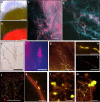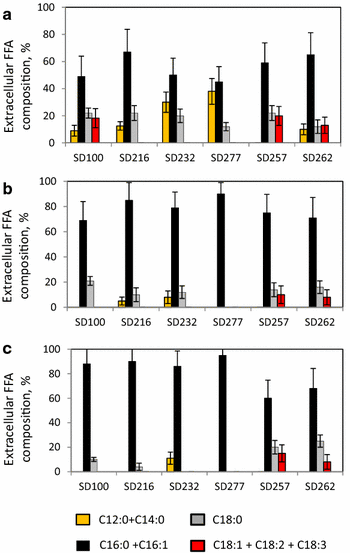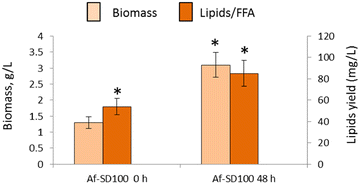Lipid production in association of filamentous fungi with genetically modified cyanobacterial cells
- PMID: 26550031
- PMCID: PMC4635583
- DOI: 10.1186/s13068-015-0364-2
Lipid production in association of filamentous fungi with genetically modified cyanobacterial cells
Abstract
Background: Numerous strategies have evolved recently for the generation of genetically modified or synthetic microalgae and cyanobacteria designed for production of ethanol, biodiesel and other fuels. In spite of their obvious attractiveness there are still a number of challenges that can affect their economic viability: the high costs associated with (1) harvesting, which can account for up to 50 % of the total biofuel's cost, (2) nutrients supply and (3) oil extraction. Fungal-assisted bio-flocculation of microalgae is gaining increasing attention due to its high efficiency, no need for added chemicals and low energy inputs. The implementation of renewable alternative carbon, nitrogen and phosphorus sources from agricultural wastes and wastewaters for growing algae and fungi makes this strategy economically attractive.
Results: This work demonstrates that the filamentous fungi, Aspergillus fumigatus can efficiently flocculate the unicellular cyanobacteria Synechocystis PCC 6803 and its genetically modified derivatives that have been altered to enable secretion of free fatty acids into growth media. Secreted free fatty acids are potentially used by fungal cells as a carbon source for growth and ex-novo production of lipids. For most of genetically modified strains the total lipid yields extracted from the fungal-cyanobacterial pellets were found to be higher than additive yields of lipids and total free fatty acids produced by fungal and Synechocystis components when grown in mono-cultures. The synergistic effect observed in fungal-Synechocystis associations was also found in bioremediation rates when animal husbandry wastewater was used an alternative source of nitrogen and phosphorus.
Conclusion: Fungal assisted flocculation can complement and assist in large scale biofuel production from wild-type and genetically modified Synechocystis PCC 6803 strains by (1) efficient harvesting of cyanobacterial cells and (2) producing of high yields of lipids accumulated in fungal-cyanobacterial pellets.
Keywords: Biofuel; Bioremediation; Flocculation; Fungi; Genetic modification; Renewable energy; Synechocystis PCC 6803; Wastewater treatment.
Figures






Similar articles
-
Fungal-assisted algal flocculation: application in wastewater treatment and biofuel production.Biotechnol Biofuels. 2015 Feb 15;8:24. doi: 10.1186/s13068-015-0210-6. eCollection 2015. Biotechnol Biofuels. 2015. PMID: 25763102 Free PMC article.
-
Co-cultivation of fungal and microalgal cells as an efficient system for harvesting microalgal cells, lipid production and wastewater treatment.PLoS One. 2014 Nov 24;9(11):e113497. doi: 10.1371/journal.pone.0113497. eCollection 2014. PLoS One. 2014. PMID: 25419574 Free PMC article.
-
Applications of microalgal biofilms for wastewater treatment and bioenergy production.Biotechnol Biofuels. 2017 May 10;10:120. doi: 10.1186/s13068-017-0798-9. eCollection 2017. Biotechnol Biofuels. 2017. PMID: 28491136 Free PMC article.
-
Co-culture of fungi-microalgae consortium for wastewater treatment: A review.Bioresour Technol. 2021 Jun;330:125008. doi: 10.1016/j.biortech.2021.125008. Epub 2021 Mar 17. Bioresour Technol. 2021. PMID: 33773267 Review.
-
Upflow anaerobic sludge blanket reactor--a review.Indian J Environ Health. 2001 Apr;43(2):1-82. Indian J Environ Health. 2001. PMID: 12397675 Review.
Cited by
-
Potential role of N-acetyl glucosamine in Aspergillus fumigatus-assisted Chlorella pyrenoidosa harvesting.Biotechnol Biofuels. 2019 Jul 10;12:178. doi: 10.1186/s13068-019-1519-3. eCollection 2019. Biotechnol Biofuels. 2019. PMID: 31320926 Free PMC article.
-
Enhancing oil production and harvest by combining the marine alga Nannochloropsis oceanica and the oleaginous fungus Mortierella elongata.Biotechnol Biofuels. 2018 Jun 22;11:174. doi: 10.1186/s13068-018-1172-2. eCollection 2018. Biotechnol Biofuels. 2018. PMID: 29977335 Free PMC article.
-
Enhanced production of amylase, pyruvate and phenolic compounds from glucose by light-driven Aspergillus niger-CuS nanobiohybrids.J Chem Technol Biotechnol. 2023 Mar;98(3):602-614. doi: 10.1002/jctb.7153. Epub 2022 Aug 11. J Chem Technol Biotechnol. 2023. PMID: 37066082 Free PMC article.
-
Symbiotic Associations: Key Factors That Determine Physiology and Lipid Accumulation in Oleaginous Microorganisms.Front Microbiol. 2020 Dec 16;11:555312. doi: 10.3389/fmicb.2020.555312. eCollection 2020. Front Microbiol. 2020. PMID: 33391195 Free PMC article. Review.
-
Filamentous fungal pellets as versatile platforms for cell immobilization: developments to date and future perspectives.Microb Cell Fact. 2024 Oct 16;23(1):280. doi: 10.1186/s12934-024-02554-3. Microb Cell Fact. 2024. PMID: 39415192 Free PMC article. Review.
References
-
- Wu YH, Hu HY, Yu Y, Zhang TY, Zhu SF, Zhuang LL, Zhang X, Lu Y. Microalgal species for sustainable biomass/lipid production using wastewater as resource: a review. Renew Sust Energ Rev. 2014;33:675–688. doi: 10.1016/j.rser.2014.02.026. - DOI
-
- Rajkumar R, Yaakob Z, Takriff MS. Potential of the micro and macro algae for biofuel production: a brief review. Bioresources. 2014;9:1606–1633.
-
- Schenk PM, Thomas-Hall SR, Stephens E, Marx UC, Mussgnug JH, Posten C, Kruse O, Hankamer B. Second generation biofuels: high-efficiency microalgae for biodiesel production. Bioenerg Res. 2008;1:20–43. doi: 10.1007/s12155-008-9008-8. - DOI
-
- Borowitzka MA, Moheimani NR. Sustainable biofuels from algae. Mitig Adapt Strat Gl. 2013;18:13–25. doi: 10.1007/s11027-010-9271-9. - DOI
LinkOut - more resources
Full Text Sources
Other Literature Sources

